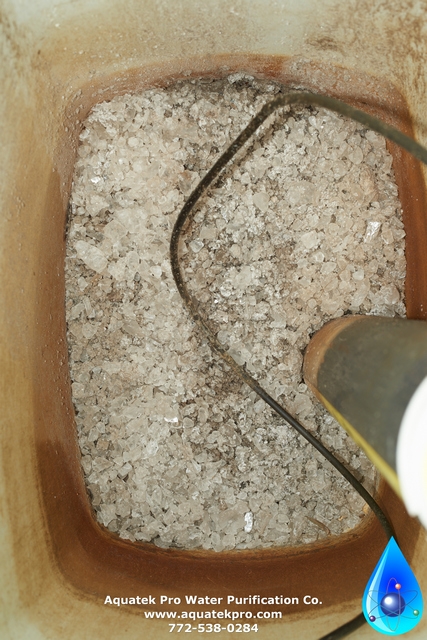I have a water softener but, still get iron staining, why?
I have a water softener but, still get
iron staining, why?
Q:
I have a working Water Softener, but
I am still getting Iron Staining, Why is that?
A:
Because, water softeners are poor
devices for removing a large amount of iron.
Water softeners are poor devices for
removing a large amount of iron (1 PPM and higher). One part per
million of iron, will consume five grains of water softener capacity
where, one grain of hardness will only consume one grain of capacity.

Iron staining on drain
Water Softener and iron calculations
Example:
If water softener capacity = 30,000
grains
30 gr. hardness per gallon = -30 gr.
capacity or 1,000 gallons of water
now add
1 PPM iron per gallon = -5 gr. capacity
or 857 gallons of water total (-143)
2 PPM iron per gallon = -10 gr.
capacity or 750 gallons of water total (-250)
3 PPM iron per gallon = -15 gr.
capacity or 666 gallons of water total (-334)
So, if you are 30 gr. hard and have
just 1 PPM iron on a 30000 gr. water softener with 4 people in the
home consuming 100 gpd (national. avg.) each, your regeneration
interval with a 400 gal. final day reserve = 857 – 400 = 457 =
every 2 days or approx. $750.00 per year in salt if salt is $7.87 for
40 lbs.
Iron is great for companies that sell
salt
Iron is great for companies that sell
salt, but not great for you because, your water softener will use
more salt by needing to regenerate more frequent. Never purchase a
water softener that is too small because, it is cheaper than the
other company it will cost you more money in salt. Water softeners
are subject to iron fouling. Water softeners become iron fouled
because, they don’t like to let go of the iron as easy as the
hardness (calcium and magnesium). The iron sticks to the softening
resin and it takes a mild acid to get it out. Salt alone will not get
the iron out of the system. Water softeners are hardness filters, not
iron filters.

Iron fouled softening resin
If your water softener has been in
operation for a few years, your iron may have increased since, the
water softener was placed into service. When iron increases, it
lowers the amount of water a water softener can process and now, may
need to regenerate every day which, will double your salt bill. A
water test should be conducted every year to determine if your iron
problem has gotten worse since, the system was installed.
There are several other things that
could cause you to still be getting iron staining from your water
softener assuming it is running under capacity.
1. It is critical that your system
never run empty of salt and it is able to pull salt from the brine
tank.
2. It is important that the time of day
be kept correct and that no one uses water between 2 am – 3 am
(default regeneration time for most water softeners) when the system
is regenerating. While the system is in regeneration, any water used,
would be unconditioned waste water and salt will be pulled into the
structure.
3. It could be, your resin tank is too
small to handle all the iron and may have become iron bound. A water
test will determine if your system is too small or under capacity. A
water test can also determine if the system is iron bound.
4. It could be you are not regenerating
often enough, or using enough salt per regeneration for the small
unit you have or your family has grown and there are more people
using more water. A water softener built for two, will surely become
over taxed with four.
5. It could be that your iron content
exceeds the recommended maximum. 1 cu. ft. of resin which, can
effectively remove up to 1 part per million iron without
significantly degrading water softener performance.
6. On rare occasions the iron could be
coming from the water heater tank. If your water heater is more than
10 years old, it could be rusting out on the inside, thus putting
iron back into the water. This is also true in older homes, over 20
years old, that used galvanized plumbing. Run water out your tap to
see if the iron is mostly on the hot side. A water test can also
determine the source of the iron.

Evidence of a system totally
contaminated by iron.
Above are the common reasons a working
water softener might still be allowing you to get iron staining. The
real solution is to remove the iron before it gets to the water
softener, so, the softener can do what it was designed to do. Water
softeners are hardness filters, not iron filters. For additional help
and recommendations, call us at 772-538-0284 and we will assist you
in eliminating the iron problem.
